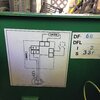Follow along with the video below to see how to install our site as a web app on your home screen.
Note: This feature may not be available in some browsers.
The OP has to find out if 240 V is needed for the electronics, as it might be that it runs from 400 V. The actual electronics will run from a low voltage through a transformer, so either 240 V or 400 is possible.Would it be better to replace the 3 phase motor with a 240 v motor then run the whole system on 240 v Ac
If the machine doesn't need the neutral, and is not damaged by going the wrong way, then I would agree with all of that.Having talked to a electrical person and he told that it dos not matter about the 4 wires only the earth.
the 3 wires are all 240 volt each and if the mot r is going the wrong way just change 2 wires .
I will let you know how it goes. Thank you Greg The Electrical person he said tha the electronicies will Nt be damaged
Can you post a good clear photo of the data plate on the side of the motor? That may clarify some details as well.
The "termination" on your drawing in the first post is puzzling; I wonder if it is a three phase motor, or capacitor run, or some other variant?
The wheel balancers I've see working tend to be very "gentle" in starting and accelerating, which is not what you would expect from a direct-on-line three phase motor.








